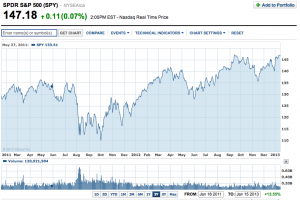When I first read a headline about a “platinum coin” being a “solution” to the ongoing U.S. Debt Ceiling struggle, I was absolutely certain it was a joke!
Much to my surprise, I soon started reading commentary from respected experts who actually see some merit in the idea, among whom is the CEO of investment behemoth, Pimco: Mohammed El-Erian.
First, allow me to provide background. A year and a half ago, in July/August of 2011, we faced much the same debt ceiling deadlock that we face now in just 45 days. During the 2011 debate, Congress demonstrated its penchant for preferring ideological posturing over reasoned compromise. The result was a “double whammy”: 1) the stock market tanked (see the valley in the accompanying chart); and 2) Standard & Poor’s cut the U.S. credit rating downward from “Triple A” (for the first time in history).
All persons of sound mind hope that we will be spared déjà vu this time around with regard to the “ceiling debate”. But some (like Treasury Secretary Timothy Geithner) have evidently been staying awake at night dreaming up ways to forestall a debt ceiling stalemate.The result has been the notion of the U.S. Treasury unilaterally creating one trillion dollars through a platinum coin (platinum is near “parity” to the price of gold). Forgetting for a moment just how big such a coin would need to be to actually justify a value of one trillion dollars, what follows is some commentary from Pimco CEO Mohamed El-Erian (writing for Fortune magazinehttp://finance.fortune.cnn.com/tag/platinum-coin/) on why the idea is worth considering:
“The platinum coin option is, according to many experts, a perfectly legal way for the administration to preemptively remove the threat of another debt ceiling debacle …”.The U.S. Treasury already has legal authority to mint coins. It could create a very large platinum coin, declare it to hold a value of $1 trillion, and issue that coin to itself, for deposit into the Treasury’s account with the Federal Reserve. (I still can’t believe that I am taking this seriously!) Then, the Treasury would draw out (on the strength of that new $1 trillion credit) the more customary forms of money, with which the U.S. could meet the accumulated interest, expenses, and payment obligations due under law.
El-Erian emphasizes the political simplicity of this option: “The key here is that the Treasury would raise money without borrowing. Thus, the increasingly binding debt limit would not apply; and congressional Republicans would be unable to hold the country hostage as happened just 18 months ago.”
When asked what financial market fallout might result, El-Erian was surprisingly sanguine: “I suspect that market reaction would be generally calm if the option were used as a way to diffuse what could otherwise be a repeat of the debt ceiling debacle in the summer of 2011.”
In his defense, El-Erian did stipulate that the political risk could be substantial, unless the very disconnected, broken financial practices of Congress are rationalized in ways that directly connect annual budgeting with the proper control and management of national debt: “It was not so long ago that sensible people would have deemed a platinum coin option as a laughable nonstarter. The fact that it is now being discussed so widely speaks loudly to the mess Congress has gotten itself (and the country) in.”
One commentator artfully alluded to the 1922 F. Scott Fitzgerald novella, The Diamond as Big as the Ritz,as a telling analogy for this platinum scheme. I encourage you to digest the brief outline/summary of the story in Wikipedia (or any other resource you find through the web). It will offer you both moments of recognition and several cynical smiles!
To whet your appetite, the grandfather of the narrator’s college friend, Fitz-Norman Culpepper Washington (related to George), discovers a Montana mountain that is one huge solid diamond! Bringing the essential laws of economics to bear on his incredible discovery (and good fortune), he finds himself on the horns of a huge dilemma: “the value of diamonds multiplied by the sheer number available for him to mine would make him the richest man ever to live, but, based on the economic law of supply, the sheer number of diamonds, if ever discovered by outsiders, would drive their value to near zero, thus making him a pauper.” http://en.wikipedia.org/wiki/The_Diamond_as_Big_as_the_Ritz
That is an incredibly succinct literary analogy to what will happen to the value of the expression, “full faith and credit of the United States”, if the Treasury can unilaterally create $1 trillion out of thin air through a coin of any metal that is arbitrarily valued.”
The compelling power of Fitzgerald’s novella is demonstrated by the number of times it has been translated into radio, television, or movie. In 1945, Orson Welles adapted it into a radio play; a different version was presented on the program, Escape, three times during the following four years; and the television show, Kraft Theatre, broadcast the story in 1955. However, the most symbolically powerful production of this Fitzgerald tale came in the spring of 1956, when a cartoon (#47) retold the story as The Mystery of Diamond Mountain.
Thus, we can draw a connection that directly links Timothy Geithner, the U.S. Treasury, and the U.S. Congress to Mickey Mouse. Perhaps we should have seen this coming!
Disclosure: As are millions of U.S. citizens, I am invested in U.S. Treasury Securities.
Submitted by Thomas Petty
Related Posts
Also on Market Tamer…
Follow Us on Facebook


 Why Forestar Group Stock Was Sinking This Week
Why Forestar Group Stock Was Sinking This Week